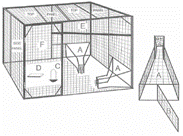Eastern Wildlife Damage Control Conferences
Date of this Version
October 1997
Document Type
Article
Abstract
Populations of piscivorous birds in North America are receiving increasing attention in the southeast United States because of depredations at aquaculture facilities. We obtained recent (most since 1994) estimates for the number of nesting double-crested cormorants (Phalacrocorax auritus), great blue herons (Ardea herodias), and great egrets (Casmerodius albus) in the United States (US) and Canada from published references and by conducting telephone interviews with state and provincial biologists. Using previously-published data, we also determined annual rates of change in the number of cormorants since about 1990. Estimates for minimum numbers of nesting pairs (minimum numbers of colonies) of double-crested cormorants, great blue herons, and great egrets were 356,000 (824), 133,000 (3,345), and 36,000 (421), respectively. Most cormorants and herons nested in the Interior Region (67% and 56%, respectively). In contrast, 74% of egrets nested in the Southeast Region. Overall, double-crested cormorants increased about 1.4% annually in the US and Canada during the early 1990s. The greatest decline (-7.9% annual change) was for the West Coast-Alaska Region. The greatest increase (5.8% annual change) was for the Interior Region. The increase in the Interior Region was a consequence primarily of a 23% annual increase in the number of nesting pairs of cormorants in states and provinces bordering the Great Lakes. These baseline population data are essential for monitoring trends in nesting populations and for developing informed management decisions. However, the completeness, quality, and timing of surveys varied substantially among jurisdictions; therefore, initial population figures and rates of population change are conservative estimates and should be used with caution. We recommend coordination of methodology and timing of future surveys among political jurisdictions (at least within regions) to improve accuracy of estimates and allow more meaningful comparisons of population status. Based on these estimates, the <8,000 double-crested cormorants, <3,000 great blue herons, and <2,000 great egrets killed annually via depredation permits at aquaculture facilities in the southeast US conservatively represented <3% of the respective nesting populations (<1% of the total populations) in the US and Canada. Thus, the number of these species killed at southeast US aquaculture facilities has had minimal effect on continental or regional nesting populations. We recommend continued monitoring of nesting populations in relation to lethal control at aquaculture facilities to ensure that population viability of piscivorous birds is not adversely affected.



Comments
Published in Proceedings of the Eighth Eastern Wildlife Damage Management Conference, Roanoke, Virginia, October 16–19, 1997, edited by James A. Parkhurst. Copyright © 1997 by the authors.